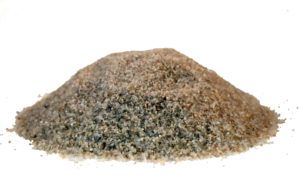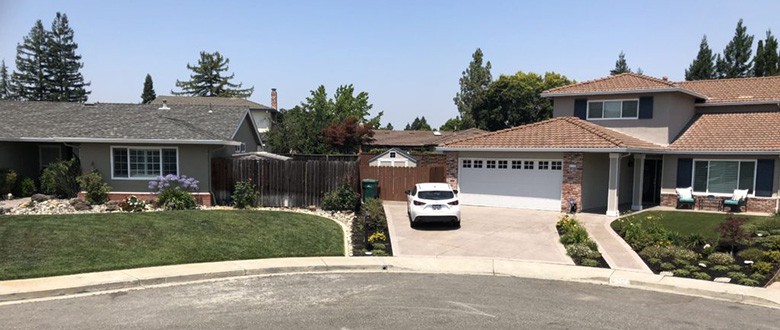For instance, take a look at the picture below, Both yards feature different varieties of grass. However, if you did not know any better, you would think the yard on the right contains real grass. Plus, the evergreen lush color makes the yard look well fertilized and watered. It’s enough to make the neighbors jealous (we hope they get jealous enough to call us).
Why Artificial Grass Looks Real
Early days of artificial grass production produced shiny, bright green blades which were an immediate tell. You didn’t have to look twice to know your neighbor had a fake lawn. However, as you can see with the image above, you would have a hard time telling the tow apart today. What happened? A lot of industry innovation for one. Here is what happened to make artificial grass look real.
Blade Variation
Old artificial grass had an almost uniform blade length. In fact, it was basically one step above indoor/outdoor carpet. The consistent blade length made for an unrealistic looking product. Grass blades do not grow at the same speed.
Current grass products contain blades of varying length. Of course, you can still choose a product with blades that resemble a freshly cut lawn. If so, you will have design variation among the blades to create an authentic look and feel. This applies to blade thickness as well. Using blades of different thickness (usually at least 3 per product design) create a sense of texture you expect fro, natural grass lawns.
Infill Material

Sand and silica infill work with artificial grass to create a realistic looking lawn.
Old materials were not as useful, or practical, as materials used today. Many companies used crumb rubber for landscape applications. While it is great for sports fields, crumb rubber has no place in your lawn. Why? Well, for one, it causes your grass to get extremely hot. And second, those little pellets will track inside your home. They also post a risk to children and pets since they seem to love putting them in their mouth.
Today, infill usually consists of silica coated sand or something similar. These remain underneath your artificial grass and provide the support your lawn needs to look authentic. Without it, your lawn will look dipped or scooped. Infill allows your lawn to have the appearance of grass that “rolls” with the landscape. This helps artificial grass look real.
Materials and Technology
This is, perhaps, one of the main reasons artificial grass looks real. New technology allows for different blade construction. Today, grass is constructed from polyurethane. UV coatings keep the grass from fading in the intense California heat. Older grass would fade over time, and it had a sheen that served as a dead giveaway. New technology uses polymers and compounds to combat the reflective nature of poly grass blades. Some products even use it to stabilize grass temperature when the sun is blazing hot.
Poly blades allow the variation needed to create authentic looking grass. Different colors create a product that looks as real and diverse as a natural grass lawn. However, one more component ties it all together. it is a necessary component needed to trick the eye. Without it, you might still be able to tell the difference.
Thatch
Take a good look at natural grass lawns. in between the blades of grass is a layer of decomposed material called thatch. This organic matter consists of dead blades of grass and other organic debris. As it decomposes, the matter slips between the blades of grass, forming a base layer of sorts. Thatch actually helps hold your grass together. However, it is tricky. Too little, and grass falls apart. Too much, and your grass can rot.
However, we still “expect” to see a bit of brown in natural grass lawns because thatch is in every lawn. It is in artificial lawns too. In fact, thatch is what makes artificial grass look real. Blade variation, density, color variation, none of it would mean anything without thatch. We need a bit of brown to trick our eyes. It’s another reason artificial grass looks real.
Look Real with NewGrass
Seems like artificial grass has come a long way since the 1980s. What started out as a product barely graded above indoor-outdoor carpet is now indistinguishable from real grass. Take another look at the picture above. It is pretty convincing. You can hardly tell the difference.
However, unlike real grass, the yard on the right will never need mowing or maintenance to maintain its lush, green appearance. Even better, no watering which means the best of both worlds. Plus, since artificial grass looks real, your neighbors will be none the wiser. Unless, you tell them of course. And we hope you do!
We would love to add another customer to the NewGrass family. We have some of the most realistic looking products on the market. Even better, they use the latest cutting edge technology to create a product that is durable, fade resistant and holds an even temperature on even the hottest of days!
Contact us and see which type of artificial grass is right for your installation. We can help you choose the right product based on the look you want and the amount of traffic you expect your lawn to receive. And keep in mind, since we are a sister company to Artificial Grass Pros, we can solve the installation part of your artificial grass lawn equation. One stop shopping with some of the best products on the market.
Finally, consider this. When the next round of California drought restrictions go into effect, you will have no worries. Your drought tolerant lawn will remain evergreen. I guess we are trying to say it will look so real you might find it unreal, but you won’t be complaining. No, you will be smiling instead.


